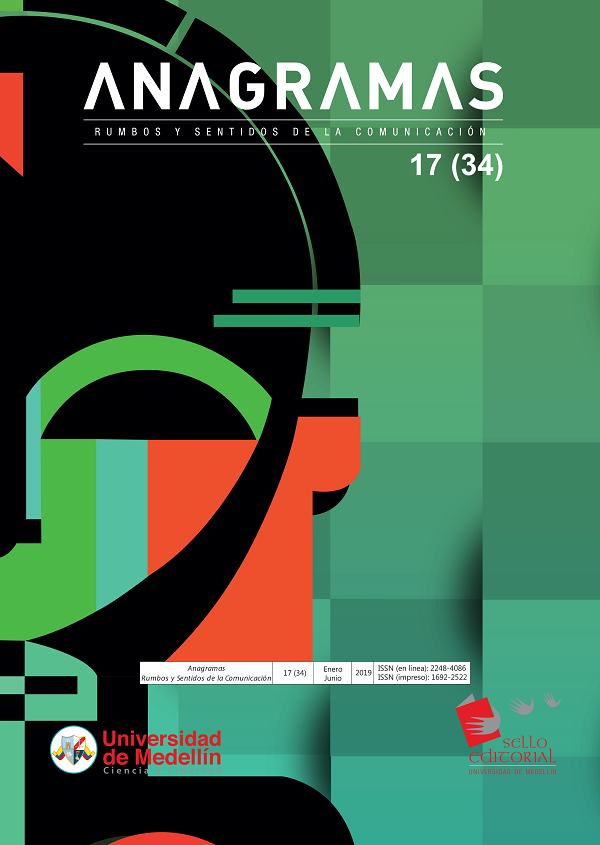Copyright (c) 2023 Anagramas Rumbos y Sentidos de la Comunicación

This work is licensed under a Creative Commons Attribution-NonCommercial-NoDerivatives 4.0 International License.
- Articles
- Submitted: March 12, 2018
-
Published: June 14, 2019
Abstract
This article presents a research on the information structure of the media with the highest audience rating in Colombia during the 2014 presidential election in Colombia. This process is widely recognized because the election campaign revolved around the peace process and had the highest abstentionism in recent years (60%), only surpassed by the 1994 presidential election. The process is analyzed from March 15 (after the legislative elections) to June 15, in order to consider both the first and second rounds, as well as the relationship with the results obtained during this electoral process. Therefore, the research was carried out with the critical discourse analysis (CDA) approach, based on the contributions of discourse analysis in terms of its structural description, but with a more stressed interest in social problems in which the abuse of power is practiced, reproduced and scarcely refuted by texts and political discourse. Considering that CDA uses empirical and practical methods for evaluating different discourses, the research takes the concepts developed by theoreticians such as Teun Van Dijk, Gilles Gauthier, Beaudoux, D’Adamo and Slavinsky, as well as the contributions of the agenda setting theory, as key referents, because that ensures the influence of the media on the public in determining and classifying the issues that have media interest. Therefore, a matrix with qualitativequantitative variables of communicational nature was designed, aimed at analyzing whether the news’ structure issued by the selected media spawned a particular political climate, and caused that candidates whose news were more in line with the climate of opinion receive more mentions and be legitimized before the population, compared to the candidates who campaigned based on issues not related to the media agenda, which ends up undermining the democracy of a fair competition between candidates, and the right of the audience to receive impartial information that allows an analysis of the proposals of all candidates without it having been previously distorted.
References
Berrocal, S. (2008). El discurso de la politica espectáculo en televisión. Un análisis de "tengo una pregunta para usted": investigar la comunicación Valladolid: Universidad Valladolid.
Diamond, L. (2003). ¿Puede el mundo entero ser democrático? Revista Española de Ciencia Política, (9), 9-38.
García, V., D’Adamo, O. y Slavinsky, J. (2005). Comunicación política y campañas electorales, análisis de una herramienta comunicacional: estrategias en elecciones presidenciales. Barcelona: Gedisa.
Gauthier, G. (1998). Comunicación y política. Barcelona: Gedisa.
González, J. (1989). El espectáculo informativo o la amenaza de lo real. Madrid: Akal Comunicación.
Holgado, M. (2003). El papel de los medios de comunicación en la campaña electoral. Ámbitos, Revista Internacional de Comunicación, 10, 32-55.
Lazarsfeld, P., Berelson, B. y Gaudet H. (1949). The people´s choice: how the voters makes up his maind in a presidential campaign. Nueva York: Columbia University Press.
McCombs, M. y Shaw, D. (1977). The emergence of american political issues: the agenda setting function of the press. Eagan: West Group.
Neumann, N. (1995). La espiral del silencio. Opinión pública: nuestra pile social. Barcelona: Paidós.
Paniagua, F. (2004). La nueva comunicacion electoral en España. Revista Latina de Comunicacion Social. 7(58), 1-14.
Pereira, J. (2007). Elecciones, campañas y medios de comunicación. Granada: Universidad de Granada.
Rodríguez, X. (2011). Resumen de the effects of mass comunication. Razón y Palabra. (75), 1-17. Recuperado de http://www.razonypalabra.org.mx/N/N75/monotematico_75/30_Rodriguez_M75.pdf
Semana. (2014). El balance del primer Santos. Recuperado de http://www.semana.com/nacion/articulo/el-balance-del-primer-santos/398507-3
Serrano, M. (2014). Elecciones presidenciales en Colombia 2014. Instituto Español de Estudios Estratégicos, (68). Recuperado de http://www.ieee.es/en/Galerias/fichero/docs_opinion/2014/DIEEEO68-2014_EleccionesColombia_MASM.pdf
Tamayo, C. (2007). Mutaciones contemporáneas: proceso electoral y medios de comunicación en Colombia 2006. En T. Mejía, E. Torrico, K. Herrera, E. Gerbet, A. Araya y N. Guzmán (Eds.), Se nos rompió el amor (elecciones y medios de comunicación -América Latina 2006) (pp.117-150). Bogotá: Centronde Competencia en Comunicación para América Latina.
Van Dijk, T. (1994). Discurso, poder y cognición social. Recuperado de https://www.textosenlinea.com.ar/academicos/Discurso%20poder%20y%20cognici%C3%B3n%20social.pdf
Vega, M. (2010). La centralidad de la televisión en el terreno de la comunicación política. Barcelona: Universidad Autónoma de Barcelona.





























